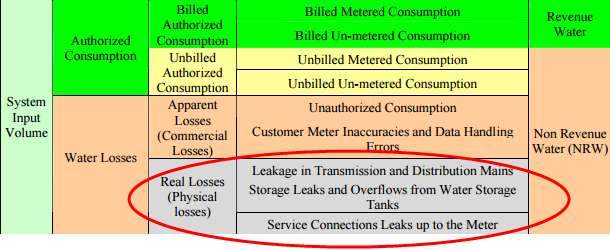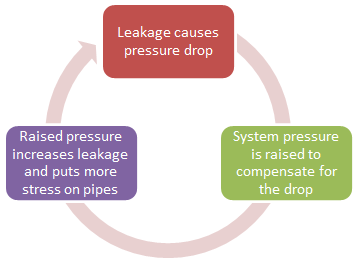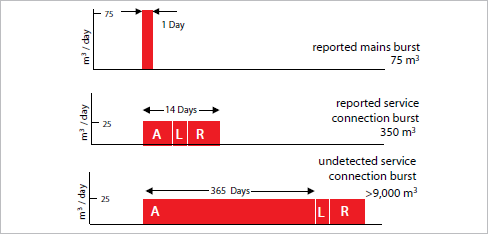
In this blog we look at the impact of real, physical losses – i.e., leakages – on NRW – Non Revenue Water.
Water utilities that proactively seek to reduce NRW will typically allocate considerable resources to preventing, detecting and repairing leaks throughout the distribution system. Leakage is a multi-faceted problem. Old or poorly constructed pipelines, poorly maintained valves, and mechanical damage are just some of the factors contributing to leakage. Dealing with leakage effectively requires a holistic, multi-disciplinary approach. One simple example of how vicious cycles can be created all too easily is the issue of pressure in the system. One effect of water leakage, besides the loss of water resources, is reduced pressure in the supply system.
However, raising pressure across the board to make up for such losses increases energy consumption, makes leaking worse and puts even more stress on the pipelines. A better solution is, for example, dividing the system into discrete pressure zones (District Meter Areas, or DMAs) and using pressure reducing valves (PRV) to regulate water supply pressure according to the unique situation in each zone.
In short, leakage management requires a multi-disciplinary approach including physical and statistical methods to detect leaks in a timely manner, careful management of pressure, and a strategic long-term program for repairing and replacing pipes.

Let’s take a closer look at the critical issue of detection and measurement since, as per the saying attributed to management guru Peter Drucker, you can’t manage what you can’t measure. The volume of water leaks is a function of the size of the leak over the amount of time it takes to detect and repair the leak. Thus, for example, when a main pipe bursts and water is gushing out like Old Faithful, a lot of water is being lost but the time to detection and repair is very short.
However, if there is an undetected leak in a less noticeable location – such as in a service connection, the rate of water loss is much smaller but it can take a very long time to detection and repair, leading overall to a far greater water loss than a burst water main. The following illustration (The Manager’s Non-Revenue Water Handbook, Ranhill Utilities Berhad & USAID, July 2008, p. 46) shows clearly that, compared to a reported mains burst, 5 times more water will be lost from a reported service connection burst and 120 times more water will be lost from an undetected service connection burst.

So how can a water utility improve its ALR time and minimize NRW from leakage?
Aside from diligent sonic monitoring of the water distribution system to physically detect hidden leaks, an end-to-end AMR/AMI solution — smart distribution and household meters + Meter Data Management (MDM) — are a critical tool for leak detection and measurement. Using CityMind, Arad’s cloud-based MDM, as an example:
- It provides real-time alerts to leaks detected directly by all meters connected to the system, including both bulk meters and household meters.
- In the case of leak detection in household meters, the utility can send an immediate message to the consumer, who can save a great deal of money by getting the leak fixed in a timely manner.
- It provides statistical alerts based on leak groups defined in the MDM system. For example, it detects the % difference between the amount of water being used and calculated in each main distribution meter vs. the water being consumed by the sub-meters that have been defined as part of the leak group. That % difference represents water that is being supplied but not charged.
- All alerts and information are sent to the relevant stakeholders by mobile and email.
- The entire water distribution system is visualized on an intuitive GIS map, with all anomalies indicated clearly.
Did you know?
- The average household’s leaks can account to for >10,000 gallons wasted each year, enough to do 270 loads of laundry.
- Household leaks waste more than 1 Trillion gallons annually in the US, equivalent to annual household water use of more than 11 million homes.
- 10% of homes have leaks that waste 90 gallons or more per day.
- Fixing household water leaks can save home-owners about 10% of their water bills.
